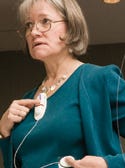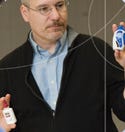April 1, 2008
MDEA 2008
|
Outstanding medical device design is often thought of in terms of out-of-the-box, sweeping innovations. While that perception is certainly appropriate, and applies to some of the 2008 Medical Design Excellence Award winners, it's not the only kind of design worth rewarding. Several of this year's winners took a technology or process that was already well known and made it better or more efficient through improved design.
“By and large, this year's winning products were refined versions of predecessor devices that serve similar functions,” says juror Michael Wiklund, PE, CHFP, president of Wiklund Research & Design (Concord, MA). “The jury found the design and engineering refinements compelling, noting that improvements in device efficacy, safety, performance, and usability can be the key to widespread adoption and greater patient benefits.”
|
MDEA juror Molly Story |
Specifically, he said, winning devices had “simpler, smaller, and more-attractive product forms; ergonomic enhancements that promised greater worker effectiveness, efficiency, and satisfaction; and higher levels of automation, eliminating the chance of use error and reducing workload.”
A subset of winners did an excellent job of eliminating steps in the caregiving process. “The trend that stood out for me was the introduction of technologies that enable healthcare providers to do more with a patient in a single visit,” says juror Molly Story, president of Human Spectrum Design LLC (Santa Rosa, CA). “These advances improve care by increasing the quality of care and by reducing the number of patient visits needed—and in some cases, time under anesthesia—which saves time and money, as well as risk to the patient.”
|
For example, two winners enable healthcare providers to fabricate objects on the spot—in one case, dental inlays and crowns; in the other case, radioactive seeds. Two others enable caregivers to assess patients on-site in ways that weren't possible before. All of these products take two or more steps and condense them into one, saving the patient a return trip or other inconvenience.
Many winners were rewarded for their strict attention to the intricacies of the user interface.
|
MDEA juror Michael Wiklund |
“Paying appropriate attention to the user interface is valuable, especially when it addresses issues such as use error or efficiency, or does not add another burdensome device to the clinician's already task-challenged life,” says juror William Hyman, ScD, MS, PE. He is a professor of biomedical engineering at Texas A&M University (College Station).
This is particularly important in the current day and age, says jury chair Herbert Voigt. “We are an aging society, so the human–machine interface must take that into account,” says Voigt, who is a professor of biomedical engineering at Boston University. “Displays must be easy to see; buttons must be easy to handle. One of the products this year had textured buttons so that it could be controlled in the dark.”
When designing an outstanding medical product, no detail is too small or insignificant, as you can see from the winners profiled in the following articles:
2008 Winning Products and Suppliers
Caring for the Caregiver
Design Appeal: The Patient Perspective
Whole-In-One: Devices that Do More
Web Exclusive! See demonstration videos of select MDEA winners.
Copyright ©2008 Medical Device & Diagnostic Industry
You May Also Like






